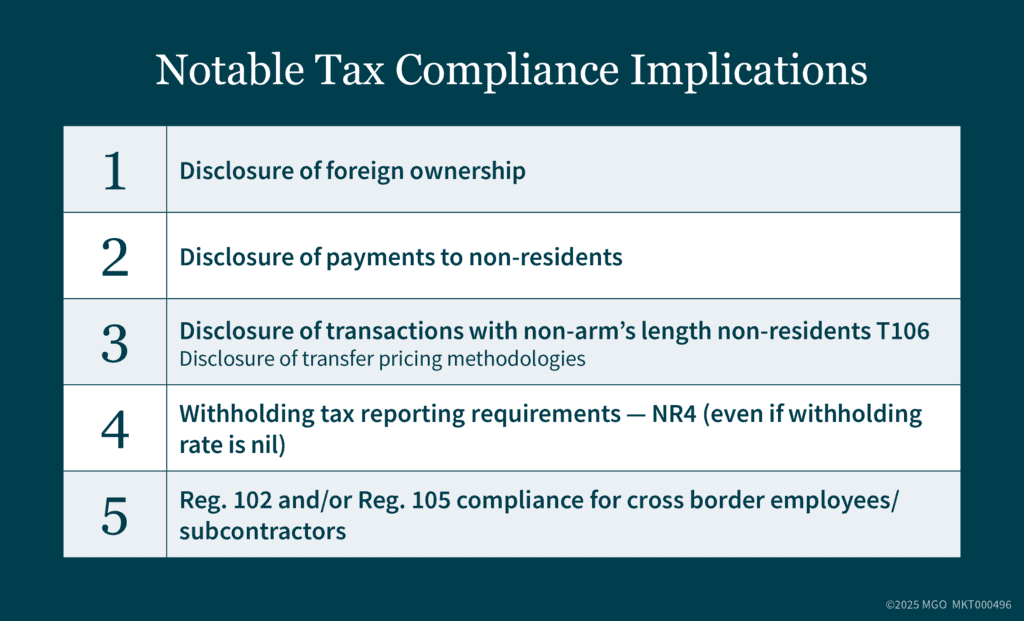Key Takeaways:
- Choosing the right investment structure is essential for successful U.S.-Canada cross-border transactions.
- Financing strategies can help improve cash flow and support tax efficiency.
- Managing tax compliance with strategies like proper transfer pricing and exact foreign reporting can help reduce risk and increase profitability.
—
Expanding your business between the United States and Canada is a strategic move that can unlock new markets and revenue streams. However, the complexities of cross-border transactions can be daunting. From tax structures to financing strategies and compliance obligations, every move requires careful planning.
We recently hosted a webinar with Canada-based CPA Solutions designed to help businesses confidently expand into the U.S. from Canada or into Canada from the U.S. Here are some key takeaways from that discussion.
Making the Right Investment Structure Choices
Choosing the right investment structure is fundamental to successful cross-border transactions. The three primary structures to consider when entering Canada from the U.S. are:
- Corporation: The most common structure, where a U.S. corporation sets up a Canadian corporation or acquires an existing business. These entities operate as separate legal entities, meaning that each pays taxes in its own jurisdiction. This structure helps minimize tax intermingling. However, when repatriating earnings, dividends are generally subject to withholding tax. You can also move money through management fees and interest expenses, but it’s important to understand the tax implications of each approach.
- Branch: An alternative to forming a corporation, a branch allows a U.S. company to operate in Canada without creating a separate legal entity. This possibility can be efficient for businesses wanting to expand operations without setting up a new corporate structure. Retained earnings that are reinvested in Canada typically aren’t taxed. However, repatriating funds without reinvestment triggers withholding tax. This approach can be beneficial if your goal is to keep earnings within Canada for growth while avoiding unnecessary tax burdens.
- Unlimited liability company (ULC): A hybrid entity that is treated as a corporation for Canadian tax purposes but disregarded for U.S. tax purposes. ULCs can present significant tax benefits, but they come with increased complexity due to hybrid mismatch rules. For example, some transactions may be deductible in Canada but not treated as income in the U.S., or vice versa. Navigating these nuances requires a thorough understanding of both tax codes and how they interact under the Canada-U.S. treaty.
Choosing the right structure requires balancing your business model, growth ambitions, and tax planning strategies. Consulting with knowledgeable professionals who understand both sides of the border is important to avoid costly pitfalls.
Financing Strategies to Fuel Your Expansion
Funding your cross-border investment efficiently is crucial to keeping profitability. There are three main approaches to financing:
- Equity financing: Investing in shares to create paid-up capital, which can be returned tax-free. This approach is especially beneficial when your goal is long-term growth, as future capital gains from selling shares may also be favorable. You can also pay dividends back to the U.S. without withholding tax, provided you meet treaty requirements. However, equity financing may limit your ability to extract surplus quickly.
- Debt financing: Loans offer tax-free principal repayments and allow interest charges to move surplus across borders. To deduct interest in Canada, the debt-to-equity ratio must not exceed 1.5:1. If the ratio is higher, excess interest is treated as a dividend and subject to withholding tax. Maintaining the right balance is necessary to preserve tax efficiency while using debt’s cash flow benefits.
- Debt-equity mix: Combining both equity and debt to balance growth potential with tax efficiency. This approach provides flexibility while keeping favorable tax treatment if ratios are carefully managed. A common strategy is to set up a 1.5:1 ratio, allowing interest deductions while keeping equity growth potential.

Tax Compliance Implications for Inbound Canada/Outbound U.S.
When conducting cross-border transactions between Canada and the U.S., it’s important to navigate tax compliance from both perspectives to avoid unexpected liabilities. Here are key considerations for inbound Canada/outbound U.S. transactions:
- Permanent establishment (PE) status: Determining whether your business activities in Canada create a permanent establishment is critical. If no PE exists, profits may not be taxed in Canada. However, proper documentation is important to support a non-PE status, as failing to file can result in penalties.
- Withholding tax obligations: Repatriating earnings from Canada to the U.S. — whether as dividends, interest, or royalties — may trigger withholding tax. The standard rate is 25%, but treaty benefits can reduce this to 5% or even 0% for certain payments, like interest. Always file the necessary forms to claim reduced rates.
- Transfer pricing considerations: Make sure that intercompany pricing aligns with arm’s-length principles to avoid disputes. This includes loans, royalties, and service fees between U.S. and Canadian entities. Documenting the rationale behind your pricing strategy is important to meet compliance requirements and avoid penalties.
- Foreign reporting requirements: Canadian tax law mandates the disclosure of foreign ownership and payments to non-residents. This includes management fees, royalties, and interest payments, as well as transactions exceeding $1 million (CAD) annually. Failing to report accurately can result in fines and audits.
- Employee movement compliance: If employees cross the border to conduct business activities, understand the regulations that apply to payroll taxes, social security, and reporting obligations. Both countries may impose requirements on income earned while working abroad.
Proactively managing these compliance aspects can help you minimize tax exposure and keep smooth cross-border operations. Working with experienced advisors familiar with both tax systems is important to avoid costly mistakes.

Transfer Pricing Considerations
Transfer pricing is a critical tool for managing cash flow between U.S. and Canadian entities. Besides dividend payments, transfer pricing allows for efficient cash repatriation while minimizing tax liabilities. Implementing well-planned transfer pricing strategies can provide immediate cash flow or support long-term financial planning.
Key transfer pricing considerations to improve your cross-border transactions include:
- Interest payments: Charging interest on intercompany loans can be an effective way to move surplus funds from a Canadian entity to its U.S. parent. However, it’s crucial to analyze the credit risk associated with the borrower and perform a credit rating analysis at the time of loan initiation. Interest payments may qualify for reduced withholding tax rates under treaty benefits.
- Royalty collections: If intellectual property (IP) is held by the parent company and utilized by a Canadian subsidiary, charging royalties can be an efficient way to transfer cash back to the U.S. Prepayments on future royalty obligations can accelerate cash flow, but it’s important to calculate the present value of these prepayments based on projected revenue.
- Management service fees: If the U.S. parent company provides services — such as administrative or management support — to its Canadian subsidiary, charging management service fees can be an effective strategy. The U.S. tax code outlines detailed rules for what costs can be included, so be thorough in finding which expenses help the foreign entity.
- Other cross-border charges: Beyond interest, royalties, and management fees, other intercompany charges, such as cost-sharing arrangements or distribution charges, can help manage cash flow across borders. Adjusting intercompany pricing to reflect market conditions while keeping arm’s-length standards allows for flexibility in moving funds.
It’s important to keep comprehensive transfer pricing documentation to support your approach — including economic analyses and risk assessments. Proper documentation helps mitigate audit risks and shows compliance with both U.S. and Canadian regulations.
Your Path to Successful Cross-Border Transactions
Unlocking cross-border transactions requires a strategic and informed approach. With careful planning and the right guidance, you can use international opportunities while minimizing risks and staying compliant.
How MGO Can Help
At MGO, we understand the challenges and opportunities inherent in cross-border expansion and are here to help you navigate the complexities with confidence. Our International Tax team offers the guidance you need to manage tax and transfer pricing effectively and prevent or resolve any issues.
Have questions about your cross-border expansion? Reach out to our team today.

